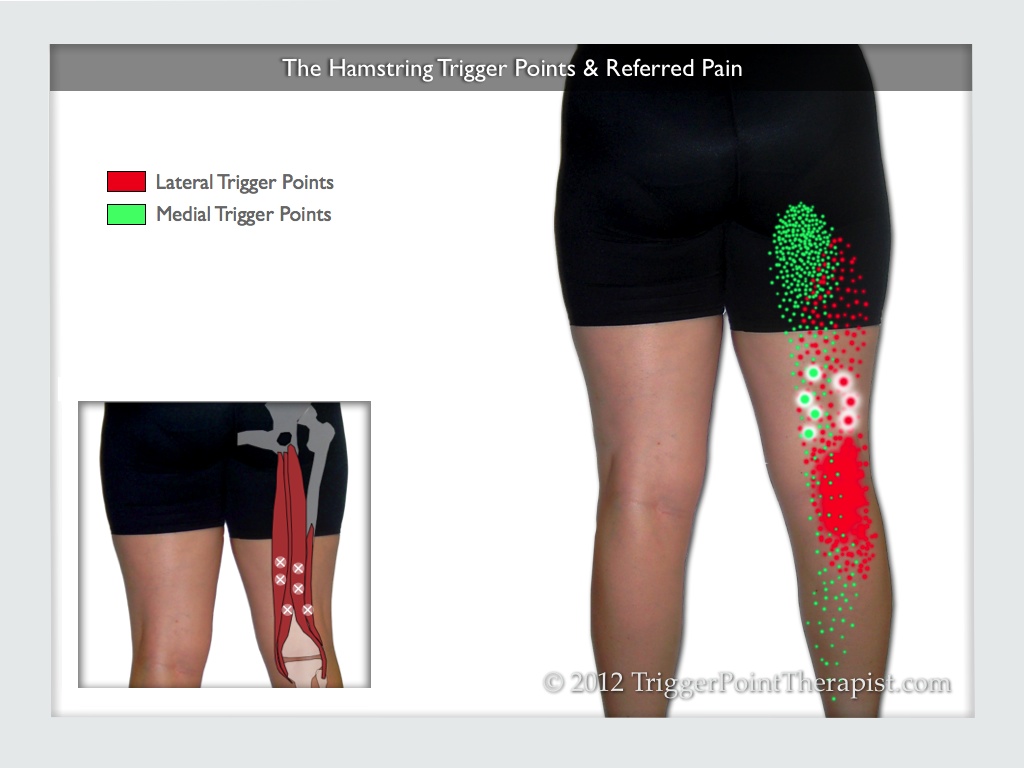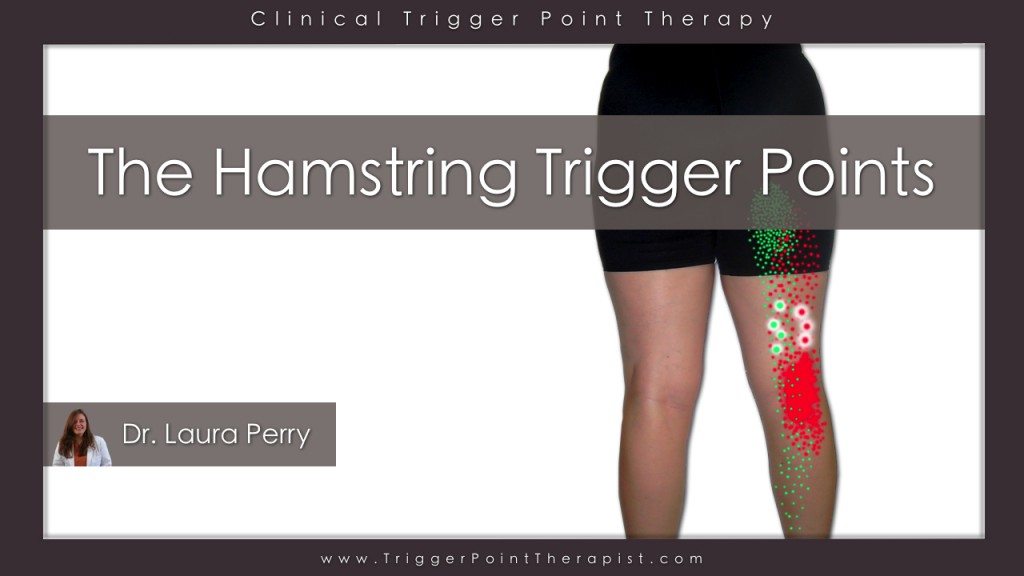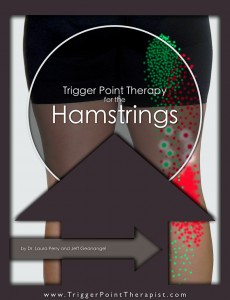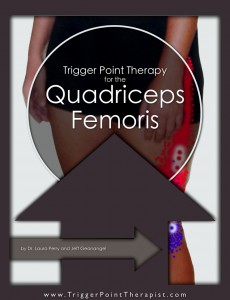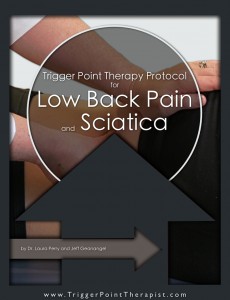The hamstring muscle group is the workhorse of human ambulation. Just to stand upright requires a continuous effort from these muscles, making them some of the most overworked muscles in the body.
Where there is muscular overload there is trigger point activity, and the hamstrings are frequently a hotbed of both latent and active trigger points. These trigger points cause the obvious symptoms of back of the thigh and knee pain, but they also play a prominent, but less obvious, role in a whole range of musculoskeletal complaints.
By creating postural distortions, the hamstring trigger points can contribute significantly to both low back pain and neck pain complaints. Understanding the true clinical impact that these trigger points can have throughout the body, is the first step a person can take on the road to becoming a phenomenal trigger point therapist.
The Hamstring Muscle Group
The hamstring muscle group lies on the back of the thigh and is composed of three muscles: the biceps femoris, the semitendinosus, and the semimembranosus.
In everyday activity, the hamstrings undergo an eccentric contraction to control the tendency of bodyweight to cause the trunk to flex forward on the pelvis. They also function to control the forward movement of the leg during walking.
Muscle Structure & Attachments: The four components of the hamstring muscle group are detailed below:
- The semitendinosus muscle lies on the medial aspect of the posterior thigh. This muscle originates on the ischial tuberosity of the pelvis and runs down the leg to attach below the medial condyle on the tibia. The belly of this muscle is found in the top portion of the posterior thigh.
- The semimembranosus muscle also lies on the medial aspect of the posterior thigh, with its broad muscle belly in the lower half of this region (closer to the knee). It attaches to the ischial tuberosity of the pelvis and runs deep to the other hamstring muscles to attach to the medial condyle of the tibia just below the knee joint capsule.
- The bicep femoris muscle has two heads (or divisions) that lie on the lateral aspect of the posterior thigh; the long head and the short head. The long head of the biceps femoris attaches to the ischial tuberosity and runs diagonally downward and laterally to attach to the head of the fibula bone.
- The short head of the biceps femoris attaches along the linea aspera on the shaft of femur bone and runs diagonally outward to join the tendon of the long head as it attaches to the head of the fibula.
The semitendinosus, semimebranosus, and long head of the biceps femoris cross both the hip and knee joints and are referred to as the “true hamstrings.” The short head of the biceps femoris only crosses the knee joint.
The skeletal landmarks and muscular attachments of the hamstring muscles are shown in excerpt from the Trigger Point Therapy for the Hamstrings Video below.
Muscle Actions: All four components of the hamstring group act to flex the leg at the knee.
- Contraction of the three “true hamstrings” produces extension of the thigh at the hip.
- With the hip extended, the semitendinosus and semimembranosus muscles assist with medial rotation of the thigh at the hip, while the long head of the biceps femoris laterally rotates the thigh at the hip.
- When the knee is flexed, the semitendinosus and semimembranosus can act to medially rotate the lower leg at the knee, while both heads of the biceps femoris can rotate the lower leg laterally.
The Hamstring Trigger Points
As shown in diagram below, the hamstring muscle group contains two clusters of trigger points:
- The medial cluster can contain up to 5 trigger points that are located about mid-thigh, along the inside of the leg.
- The lateral cluster can contain up to 4 trigger points that are located about mid-thigh along the outside aspect of the leg.
In most cases involving hamstring trigger points, I typically find only 3 active trigger points; two in the lateral cluster which I refer to as the lower and middle hamstring trigger points, and one in the medial cluster which I refer to as the medial hamstring trigger point. In chronic (stubborn) low back pain cases, I will sometimes find additional active trigger points in the hamstrings.
Hamstring Muscle Pain
The diagram above also shows the referred pain patterns associated with the hamstring trigger points.
- The medial cluster trigger point(s) refer pain strongly upward to the gluteal fold/upper posterior thigh region and down the back of the thigh to the medial calf region.
- The lateral cluster trigger points refer pain primarily to the back of the knee, with some spillover referral to the back of the thigh.
What Causes Hamstring Trigger Points?
The following events or activities may activate or reactivate the hamstring trigger points:
- Physical compression of trigger points by sitting in a poorly fitting chair (chair is too big for the person and their feet don’t touch the floor).
- Sitting in cheap patio furniture that has a seat canvas suspended on a bar that runs across the front of the seat.
- Prolonged leaning forward in a chair that places the bodyweight on the thighs instead of the buttocks.
- Bending at the waist for sustained periods of time
- Sitting cross-legged for long periods of time
(For more information on the various causes of trigger points, please see What Causes Trigger Points.)
Hamstring Symptoms & Disorders
Clients with active hamstring trigger points will present with any or all of the following symptoms or clinical findings:
- Posterior thigh or posterior knee pain, worse when walking, often causes a limp.
- Pain in buttocks, back of the thigh and/or knee while sitting
- Leg pain that disturbs sleep
- Clients may also complain of quadriceps femoris trigger point symptoms due to the prominent antagonistic relationship between these muscle groups.
Treatment of Hamstring Trigger Points
Early in my career as a trigger point therapist I failed to account for hamstring trigger point activity in my low back pain clients. This omission caused the client’s back pain to quickly return after my treatment. I looked into these cases further and found that most of these low back pain complaints were initiated by an activity that overloaded the client’s hamstring muscles. Once I added the hamstring trigger points to my low back pain treatment protocol, I had much longer lasting success with these clients.
Many client’s carry a great deal of unrealized tension in their hamstrings. Over time, this tension manifests itself as a postural distortion that wreaks havoc with the muscles all along the spine, from the low back to the neck.
I have found that regularly releasing the hamstring trigger points can have a profound preventative effect in my clients, allowing them to go extended periods without developing the typical myofascial pain complaints. This is especially true for clients who are athletes, as even the presence of latent hamstring trigger points can predispose them to future hamstring strains and tears.
I designed a maintenance treatment protocol in response to this observation that incorporates the hamstring trigger points. I call this protocol the Stress Relief & Postural Protocol and recommend that my clients receive it once a month, or every other month, to keep them in a pain-free, stress-free lifestyle.
For more information on the hamstring trigger points, as well as step-by-step directions for releasing them on your clients, you can purchase the Trigger Point Therapy for the Hamstrings Video Download or the Trigger Point Therapy for the Hamstrings Booklet for the iPad.
Click on the image below to view an excerpt from the Hamstring Trigger Points video on YouTube:
Related Articles:
- Vastus Medialis Trigger Points: The Knee Pain Trigger Points – Part 3
- Rectus Femoris Trigger Point: The Knee Pain Trigger Points – Part 2
- Vastus Lateralis Trigger Points: The Knee Pain Trigger Points – Part 1
- Gastrocnemius Trigger Points: The Calf Cramp Trigger Points
- Piriformis Trigger Points: Double Trouble
- Gluteus Minimus Trigger Points: A Small Muscle With A Big Mouth
Related Instructional Videos:
